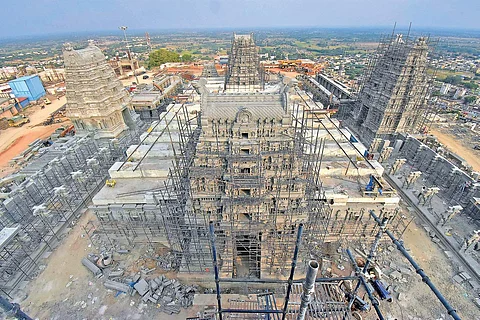

One of the most striking experiences of visiting the grand-old temples of South India is that of feeling dwarfed by the megastructures carved out of hard stone. When seen on the Vimana gopuram, which is the highest structure in any temple complex, the stone is nothing short of awe-inspiring in its graceful position atop the sacred Garbhagriha, or house of the temple deity.

In a tribute to the ancient wisdom of India’s temple architecture, the planners of the Yadagirigutta temple in the Yadadri Bhuvanagiri district, decided to restrict the reconstruction works around the ancient swayambhu temple using granite stone. Known as ‘Krishna sali’ for its colour as dark as the night, all of the 2.5 lakh metric tonnes of black granite was quarried from a single mine in Guntur, Andhra Pradesh. With over 90 per cent of the works completed, the temple is only waiting to join the ranks of Thanjavur, Srirangam or Srikalahasti—few of the greatest temples in the southern part of the sub-continent.
Usage of granite not just for the construction of temple but also for as many as seven gopurams, makes Yadagirigutta temple one of its kind in modern India. “It was only in the ancient era that every part of a temple, including the Vimana gopuram, were built out of granite stones. In the modern times, cement and bricks are used to construct gopurams,” said S Sundararajan, Sthapathi of the temple and Advisor to Yadagirigutta Temple Development Authority (YTDA).
What makes up the temple?
Entry to the Mukha mandapam, the area in front of the Garbhagriha where the swayambhu image of Lord Narsimhaswamy rests on a natural stone, will be through the inner prakaram. The inner prakaram is as wide as 108 ft, 202 ft long and 25 ft high and is enriched with ornamental carving designed by scholars of Hindu temple architecture.

Meanwhile, the magnanimous 103 ft long, 202 ft wide and 35 ft high Mukha mandapam will be centrally air conditioned. It has been beautified by 12 pillars, with one of the 12 Alvars carved on each one and weighing a hefty 80 tonnes. A slab of granite covers these pillars which further has 12 pillars built as per the Kakatiya style of architecture.
Adding to majestic look of Mukha mandapam would be the 8 ft tall and 70 ft wide Prahlada Charitra, made entirely out of silver, that will rise above the entrance to Garbhagriha.
Surrounding the first prakaram there will be a wide Mada veedhi with stone flooring which will provide space for conducting various events like Pallaki Seva, Swamy Utsavalu and will have Satyanarayana Vratha mandapam.

Adding to the grandeur of the temple would be a total of seven Gopurams, also built out of black granite. One of the gopurams, known as Sapta Tala Rajagopuram reaches a height of 80 ft. The Vimana gopuram will be 48 ft high and draped in pure gold in the near future.
Going by the progress of the works, according to Sundararajan by Sankranti next year the YTDA aims to finish the temple which is bound to be a pride for Telangana state in the near future.
‘Bound’ by traditions
In its attempt to give a tribute to the wisdom of ancient Indian architecture, the newly constructed temple chucks the modern material of cement to use lime mortar for joining individual blocks of granite. The lime mortar comprises lime, jaggery and bel fruit for bonding of two blocks, karakkaya for quick setting and jute for minimizing cracks. Explaining the significance of lime mortar, Sundararajan, Sthapathi of the temple and advisor to the YTDA said, “The lime mortar unlike cement does not weaken over time rather it becomes stronger. Its usage can be seen in historic monuments even today.”
2,500 sculptors, mostly from Tamil Nadu, worked at six different sites in Telangana and Andhra Pradesh on the granite blocks used in temple construction
Vision grandeur
Outermost part of the temple complex will have a 3 ft tall concrete wall with an iron grill upto a height of 20 ft. This is aimed to provide a hill view to the visitors and devotees. This will also be the venue to host Brahmotsavam. The complex will also have other temples dedicated to goddess Sridevi, Lord Hanuman as well as goddess Lakshmi.